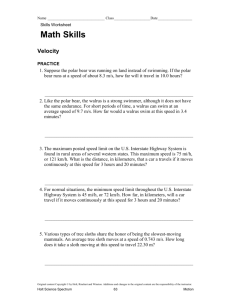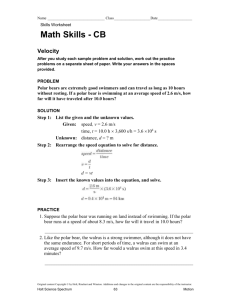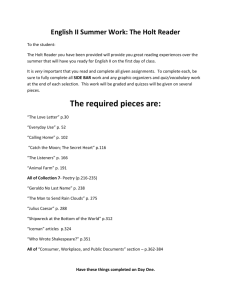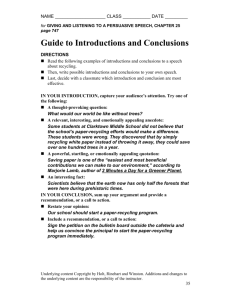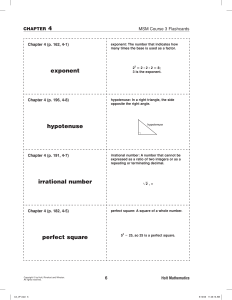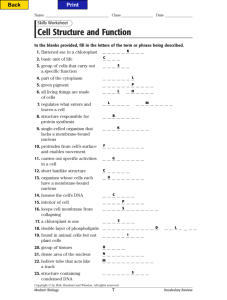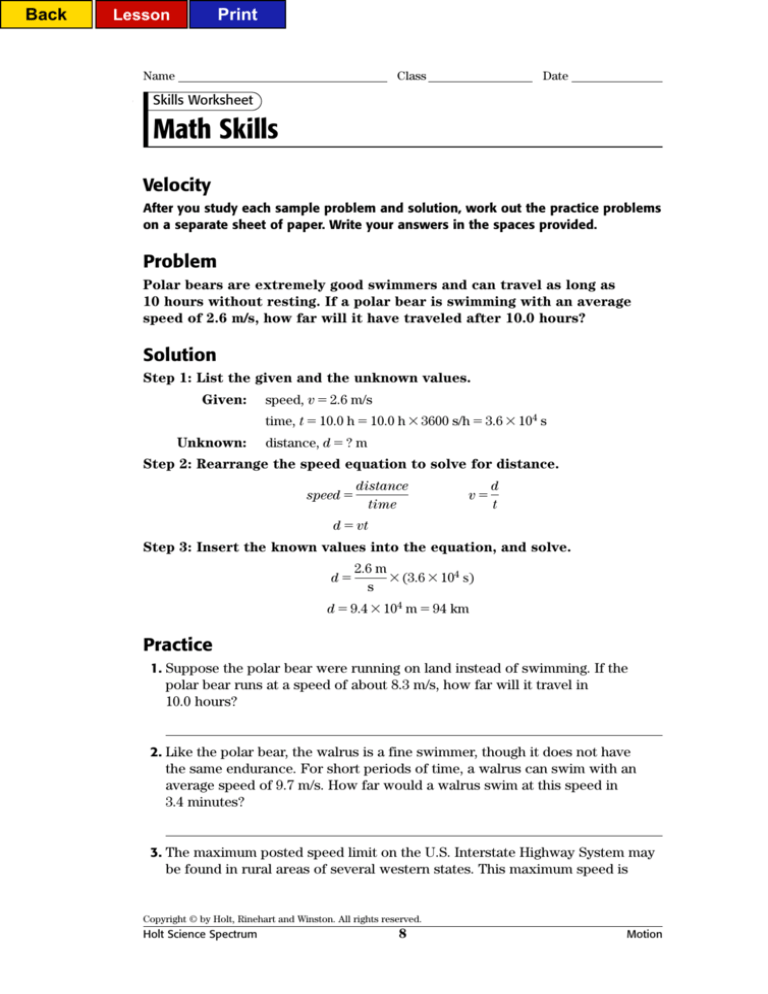
Back
Print
Lesson
Name
Class
Date
Skills Worksheet
Math Skills
Velocity
After you study each sample problem and solution, work out the practice problems
on a separate sheet of paper. Write your answers in the spaces provided.
Problem
Polar bears are extremely good swimmers and can travel as long as
10 hours without resting. If a polar bear is swimming with an average
speed of 2.6 m/s, how far will it have traveled after 10.0 hours?
Solution
Step 1: List the given and the unknown values.
Given:
speed, v 2.6 m/s
time, t 10.0 h 10.0 h 3600 s/h 3.6 104 s
Unknown:
distance, d ? m
Step 2: Rearrange the speed equation to solve for distance.
speed distance
time
v
d
t
d vt
Step 3: Insert the known values into the equation, and solve.
d
2.6 m
(3.6 104 s)
s
d 9.4 104 m 94 km
Practice
1. Suppose the polar bear were running on land instead of swimming. If the
polar bear runs at a speed of about 8.3 m/s, how far will it travel in
10.0 hours?
2. Like the polar bear, the walrus is a fine swimmer, though it does not have
the same endurance. For short periods of time, a walrus can swim with an
average speed of 9.7 m/s. How far would a walrus swim at this speed in
3.4 minutes?
3. The maximum posted speed limit on the U.S. Interstate Highway System may
be found in rural areas of several western states. This maximum speed is
Copyright © by Holt, Rinehart and Winston. All rights reserved.
Holt Science Spectrum
8
Motion
Back
Print
Lesson
Name
Class
Date
Math Skills continued
75 mi/h, or 121 km/h. What is the distance, in kilometers, traveled by a car
moving continuously at this speed for 3 hours and 20 minutes?
4. For normal situations, the minimum speed limit throughout the U.S. Interstate
Highway System is 45 mi/h, or 72 km/h. How far, in kilometers, will a car
travel if it is moving continuously at this speed for 3 hours and 20 minutes?
Problem
A baseball is pitched with a speed of 35.0 m/s. How long does it take the
ball to travel 18.4 m from the pitcher’s mound to home plate?
Solution
Step 1: List the given and the unknown values.
Given:
speed, v 35.0 m/s
distance, d 18.4 m
Unknown:
time, t ? s
Step 2: Rearrange the speed equation to solve for time.
speed distance
time
v
d
t
tv d
v v
tv d
Step 3: Insert the known values into the equation, and solve.
18.4 m
t
35.0 m/s
t 0.526 s
Practice
5. The various types of tree sloths share the honor of being the slowest-moving
mammals. An average tree sloth moves with a speed of 0.743 m/s. How long
does it take a sloth moving at this speed to travel 22.30 m?
6. The longest stretch of straight railroad tracks lies across the desolate
Nullarbor Plain, between the Australian cities of Adelaide and Perth. The
tracks extend a distance of 478 km without a curve. How long would it take a
train moving at a constant speed of 97 km/h to travel this length of track?
Copyright © by Holt, Rinehart and Winston. All rights reserved.
Holt Science Spectrum
9
Motion
Back
Print
Lesson
Name
Class
Date
Math Skills continued
7. The fastest supersonic passenger jet is the Concorde. How long would it take
the Concorde to travel the 6265 km between New York City and London,
England, assuming that the jet travels at its maximum speed of
2.150 103 km/h during the entire trip?
8. The longest distance in a field and track event is the 10 km run. The record
holder for the women’s 10 km run is Wang Junxia of China. Assuming that
Wang Junxia ran a distance of 10.00 km with an average speed of 5.644 m/s,
what was her time?
Problem
Florence Griffith-Joyner set the women’s world record for running
200.0 m in 1988. At the 1988 Summer Olympics in Seoul, South Korea,
she completed the distance in 21.34 s. What was Florence GriffithJoyner’s average speed?
Solution
Step 1: List the given and the unknown values.
Given:
distance, d 200.0 m
time, t 21.34 s
Unknown:
speed, v ? m/s
Step 2: Write out the equation for speed.
speed distance
time
v
d
t
Step 3: Insert the known values into the speed equation, and solve.
d 200.0 m
v t 21.34 s
v 9.372 m/s
Practice
9. The cheetah, the fastest of land animals, can run a distance of 274 m in 8.65 s
at its top speed. What is the cheetah’s top speed?
10. In 1985, Matt Biondi set a record for the men’s 100 m freestyle event in swimming. It took him 49.17 s to swim the 50.0 m length of the pool and swim
Copyright © by Holt, Rinehart and Winston. All rights reserved.
Holt Science Spectrum
10
Motion
Back
Lesson
Print
Name
Class
Date
Math Skills continued
back. Assume that half of Biondi’s record time was spent traveling the length
of the pool. What was his speed?
11. The fastest crossing of the Atlantic Ocean by an ocean liner was made on July
7, 1952. The ship, the S.S. United States, traveled 4727 km east by northeast
in 3 days, 10 hours, and 40 minutes. Assume that the ship had traveled the
same speed, but directly east. What would the velocity of the S.S. United
States be in kilometers per hour?
12. The bird that migrates the farthest is the Arctic tern. Each year, the Arctic
tern travels 32 000 km between the Arctic Ocean and the continent of
Antarctica. Most of the migration takes place within two four-month periods
each year. Assume an Arctic tern completes the second half of its annual
migration distance in 122 days. Also assume that during this time the tern flies
directly north. If the tern flies the same distance each day, what is its velocity
in kilometers per day?
Mixed Practice
13. The typical snail doesn’t cover very much ground even when it is moving at
its maximum speed, which is 5.0 102 m/h. How far will a snail travel if it
moves at its top speed for 45 minutes?
14. Motion pictures typically are filmed and shown at a speed of 24 frames per
second, where a frame is a single photographic image in the film. In the field
of high-speed photography, a motion-picture camera that is able to move the
film at 2.4 105 frames per second is used. When the film is reshown at
24 frames per second, the filmed object is seen to move very slowly. This
technique is used to analyze the motion of objects, like bullets, that move too
quickly to be observed by the human eye. If a frame of 16 mm film is 0.75 cm
in length, how fast does the film move through the high-speed camera when
the film is being exposed?
15. In 1926, Gertrude Ederle of the United States became the first woman to swim
across the English Channel, She also set what was at that time the world
record for the crossing, with an average speed of 0.725 m/s. Assuming that the
distance Ederle swam was 37.9 km (the shortest distance between England
and France), how long did it take her to swim the Channel?
Copyright © by Holt, Rinehart and Winston. All rights reserved.
Holt Science Spectrum
11
Motion
Back
Lesson
Print
Name
Class
Date
Math Skills continued
16. Bonnie Blair set the world record for women’s speed skating in 1995, with an
average speed of 12.9 m/s. How far would Blair have traveled at this speed in
a time of 5.00 minutes?
17. Although they seem to remain unchanged, many mountains undergo steady
growth. If erosion and weathering are ignored, some mountains, like the San
Gabriels in southern California, grow as much as 1.0 cm within a year. If a
year is considered to be exactly 365 days, what is the speed at which the San
Gabriel Mountains grow in kilometers per hour?
18. The Trans-Siberian Railroad is the longest single railroad in the world.
Starting in Moscow, the tracks stretch 9354 km across the Siberian frontier to
Vladivostok, at the edge of the Pacific Ocean. If you were to leave Moscow
and travel on the railroad with an average speed of 90.0 km/h, how long
would it take for you to reach Vladivostok?
19. The largest sheep and cattle ranches in the world are in Australia. The areas
of some of these ranches are about equal to the area of Connecticut, so the
fences needed to protect the livestock from dingos and other predators are
extensive. The world’s longest “dingo-proof” fence is 5530 km long. Suppose
you were to travel around this fence in a jeep with an average speed of
45 km/h. How long would it take you to return to your starting point?
20. Stars do not appear to move because of their tremendous distances from us.
In fact, stars move at fairly high speeds. Consider the relatively close star
Sirius, which is moving away from our solar system with a speed of about
17.8 km/s. How far will this star travel in 2590 years, the time it takes for
Sirius to move 1° across the sky?
Copyright © by Holt, Rinehart and Winston. All rights reserved.
Holt Science Spectrum
12
Motion
Back
Lesson
Print
TEACHER RESOURCE PAGE
3. a. Under the force of gravity, the car
will roll down the hill. It will accelerate as it rolls down the hill. b. The
upward force on the skydiver due to
air resistance increases, while the
downward force due to gravity stays
the same, so the skydiver slows down.
4. Answers may vary. Sample answer:
Harmful friction occurs when you
slide across a rough wooden bench.
Smoothing the surface of the bench
with sandpaper will reduce the friction.
5. a. helpful b. harmful c. helpful
d. helpful
7.
8.
9.
Science Skills
10.
SLOPE OF A LINE
11.
1
1.
5
0.6 0.2
or
2.
3.0 1.0
3. speed
RATES OF CHANGE
1. 30 weeks (2 significant figures)
2. 15 weeks (2 significant figures)
3. 5 seconds
12.
13.
Math Skills
VELOCITY
1. d vt
t 10.0 h 3600 s
3.6 104 s
h
14.
8.3 m
(3.6 104 s) 3.0 105 m
s
3.0 102 km
d vt
60 s
t 3.4 min 2.0 102 s
1 min
9.7 m
(2.0 102 s) 1.9 103 m
d
s
1.9 km
d vt
121 km
d
(3.33 h) 403 km
h
d vt
72 km
d
(3.33 h) 2.4 102 km
h
d
t
v
22.30 m
t
30.0 s
0.743 m/s
d
2.
3.
4.
5.
d
v
478 km
t
4.9 h
97 km/h
d
t
v
6265 km
t
2.914 h
2.150 103 km/h
2h 54 min 50 s
d
t
v
10 000 m
t
1772 s 29 min 32 s
5.644 m/s
d 274 m
v 31.7 m/s
t 865 s
d
50.0 m
v 1
2.03 m/s
t 2(49.17 s)
24 h
72 h
3 days 1 day
72 h 10 h 82 h
1h
40 min 0.67 h
60 min
t 82.67 h
d 4727 km
v 57.18 km/h east
t
82.67 h
1
d 2(32 000 km)
v t
122 days
131 km/day south
d vt 1h
(5.0 102 m/h)(45 min)
60 min
3.8 102 m
2.4 105 frames
7.5 103 m
1s
1 frame
1.8 103 m/s
d 37 900 m
t 5.23 104 s
v 0.725 m/s
1 min
5.23 104 s 871 min
60 s
1h
871 min 14 h, 31 min
60 min
60 s
d vt (12.9 m/s)(5.00 min)
1 min
3.87 103 m 3.87 km
1 km
(1.0 102 m)
d
1000 m
v t
24 h
365 days 1 day
1.14 109 km/h
d 9354 km
t 104 h
v 90.0 km/h
d 5530 km
120 h
t v 45 km/h
6. t 15.
16.
17.
18.
19.
Copyright © by Holt, Rinehart and Winston. All rights reserved.
Holt Science Spectrum
80
Motion
Back
Lesson
Print
TEACHER RESOURCE PAGE
9. final v 31 km/h
1000 m
1h
1 min
1 km
60 min
60 s
8.6 m/s
initial v 29 km/h
1000 m
1h
1 min
1 km
60 min
60 s
8.1 m/s
v 8.6 m/s 8.1 m/s
a 0.1 m/s2
t
5.0 s
10. v at (6.35 m/s2)(7.0 s) 44 m/s
v 750 m/s 0 m/s
11. t a
6.25 m/s2
120 s, or 2.0 min
v 0 m/s 13 m/s
12. t 4.5 s
a
2.9 m/s2
13. final v at initial v
(3.125 m/s2) (4.00 s) 0 m/s
12.5 m/s
v 0 m/s 16.98 m/s
14. t 47.6 s
a
0.357 m/s2
v 0 m/s 1.5 m/s
15. t 4.3 s
a
0.35 m/s2
16. initial v 320 km/h
1000 m
1h
1 min
1 km
60 min
60 s
89 m/s
v 0 m/s 89 m/s
a t
0.18 s
490 m/s2
17. initial v final v at
93.0 m/s (9.8 m/s2) (9.2 s)
3651days
y 24 h
60 min
60 s
1 day 1 h 1 min
20. d vt (17.8 km/s)(2590 y)
1.45 1012 km
ACCELERATION
s) 44 m/s
1. v at (0.89
2. final v at initial v
(0.33 m/s2)(23 s) 18.0 m/s
10.4 m/s
3. final v at initial v
initial v final v at
m/s2)(5.0
initial v 88.0 km/h (1.77 m/s2)
1 km
(6.00 s) 1000 m
60 s
60 min
1 min
1h
initial v 49.8 km/h
v 0 m/s 15.5 m/s
39.5 s
4. t a
0.392 m/s2
m
1000
1 km 1h
1 min
60 min
60 s 5. final v 96.5 km/h 26.8 m/s
v 26.8 m/s 0 m/s
t 3.89 s
a
6.89 m/s2
6. final v 296 km/h
1000 m
1h
1 min
1 km
60 min
60 s
82.2 m/s
v 82.2 m/s 0 m/s
t 51 s
a
1.6 m/s2
v 15.0 m/s 0 m/s
3.71 m/s2
7. a t
4.04 s
8. final v 153 km/h
1000 m
1h
1 min
1 km
60 min
60 s
42.5 m/s
v 0 m/s 42.5 m/s
a t
2.0 s
21 m/s2
3 m/s
v 5 cm/y 15 cm/y
18. a t
1.00 107 y
1.0 106 cm/y2
Cross-Disciplinary
CONNECTION TO FINE ARTS:
THE MOTIONS OF DANCE
1. The object’s state of motion or rest
will change.
2. When forces acting on the dancer's
body are balanced, they cancel one
another out and the dancer does not
move. An imbalance of forces will
cause the dancer to move.
3. It’s easier to stand on a flat foot than
on a single toe because it is easier to
keep one’s center of gravity over the
larger area of a flat foot.
Copyright © by Holt, Rinehart and Winston. All rights reserved.
Holt Science Spectrum
81
Motion


